2000 MERCEDES-BENZ SL600 Level control system
[x] Cancel search: Level control systemPage 200 of 297
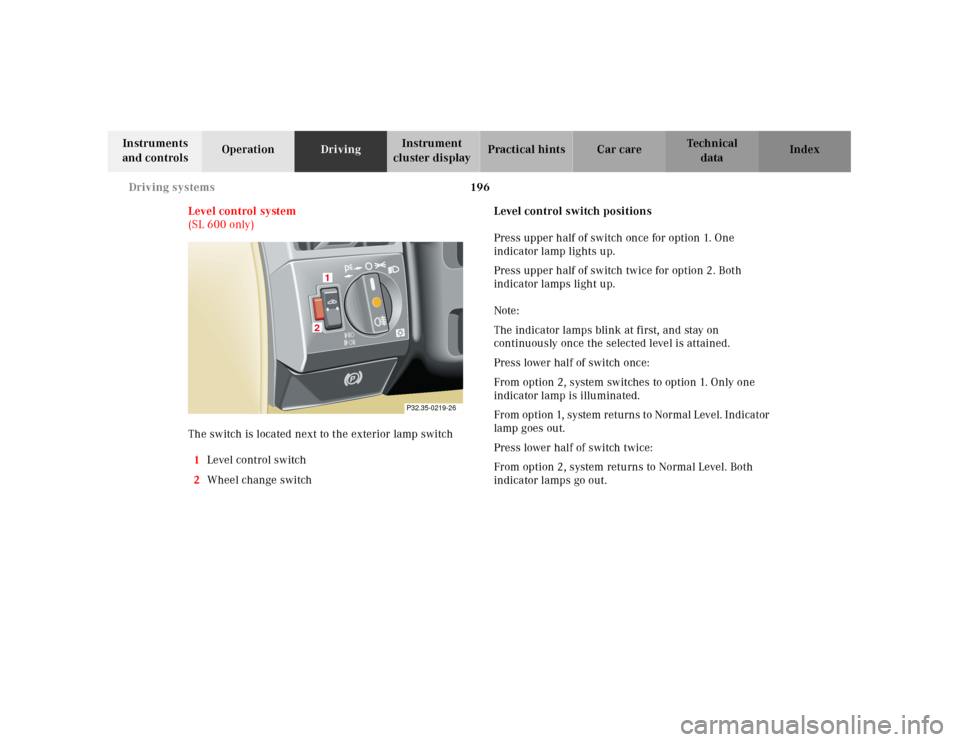
196 Driving systems
Technical
data Instruments
and controlsOperationDrivingInstrument
cluster displayPractical hints Car care Index
Level control system
(SL 600 only)
The switch is located next to the exterior lamp switch
1Level control switch
2Wheel change switchLevel control switch positions
Press upper half of switch once for option 1. One
indicator lamp lights up.
Press upper half of switch twice for option 2. Both
indicator lamps light up.
Note:
The indicator lamps blink at first, and stay on
continuously once the selected level is attained.
Press lower half of switch once:
From option 2, system switches to option 1. Only one
indicator lamp is illuminated.
From option 1, system returns to Normal Level. Indicator
lamp goes out.
Press lower half of switch twice:
From option 2, system returns to Normal Level. Both
indicator lamps go out.
12
P32.35-0219-26
Page 201 of 297
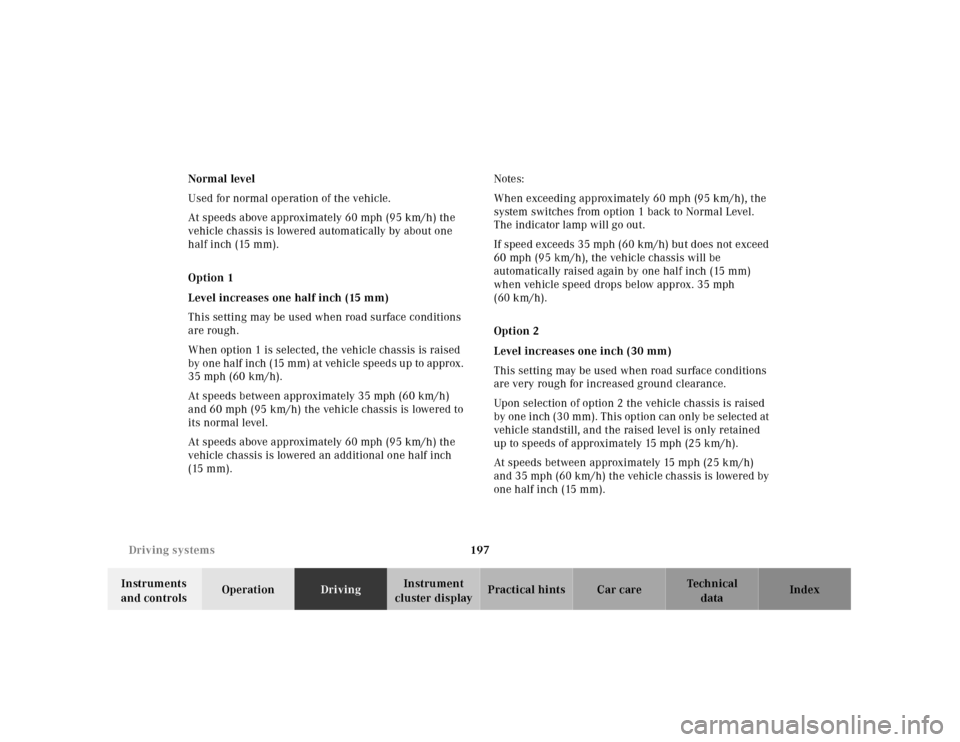
197 Driving systems
Technical
data Instruments
and controlsOperationDrivingInstrument
cluster displayPractical hints Car care Index Normal level
Used for normal operation of the vehicle.
At speeds above approximately 60 mph (95 km/h) the
vehicle chassis is lowered automatically by about one
half inch (15 mm).
Option 1
Level increases one half inch (15 mm)
This setting may be used when road surface conditions
are rough.
When option 1 is selected, the vehicle chassis is raised
by one ha lf inch (15 mm) a t vehicle speed s u p to approx.
35 mph (60 km/h).
At speeds between approximately 35 mph (60 km/h)
and 60 mph (95 km/h) the vehicle chassis is lowered to
its normal level.
At speeds above approximately 60 mph (95 km/h) the
vehicle chassis is lowered an additional one half inch
(15 mm). Notes:
When exceeding approximately 60 mph (95 km/h), the
system switches from option 1 back to Normal Level.
The indicator lamp will go out.
If speed exceeds 35 mph (60 km/h) but does not exceed
60 mph (95 km/h), the vehicle chassis will be
automatically raised again by one half inch (15 mm)
when vehicle speed drops below approx. 35 mph
(60 km/h).
Option 2
Level increases one inch (30 mm)
This setting may be used when road surface conditions
are very rough for increased ground clearance.
Upon selection of option 2 the vehicle chassis is raised
by one inch (30 mm). This option can only be selected at
vehicle standstill, and the raised level is only retained
up to speeds of approximately 15 mph (25 km/h).
At speeds between approximately 15 mph (25 km/h)
and 35 mph (60 km/h) the vehicle chassis is lowered by
one half inch (15 mm).
Page 202 of 297
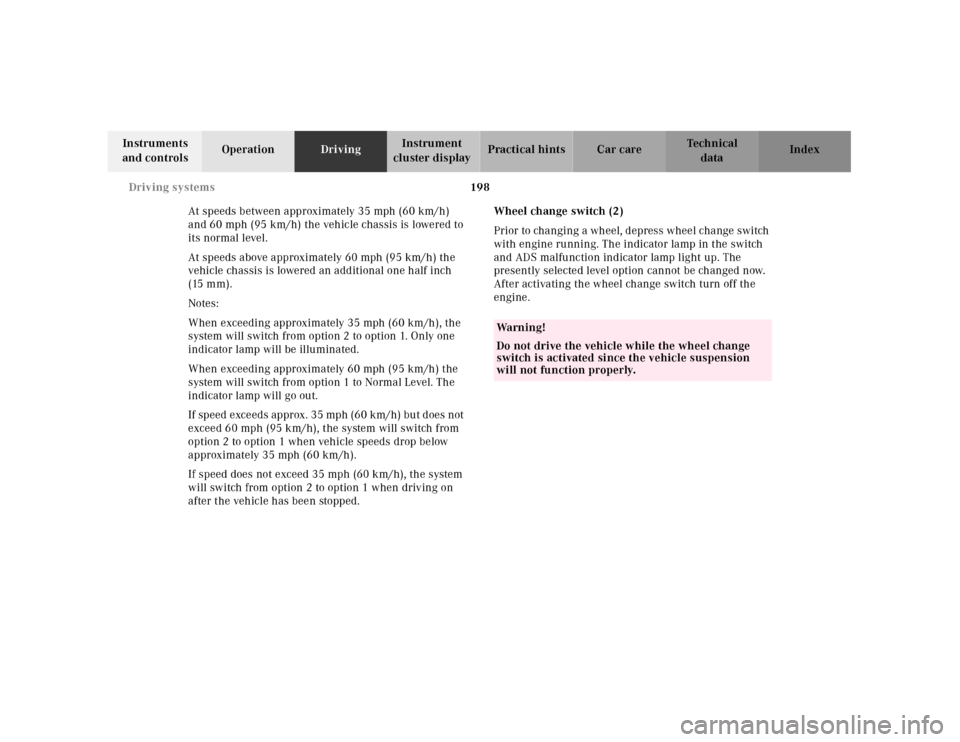
198 Driving systems
Technical
data Instruments
and controlsOperationDrivingInstrument
cluster displayPractical hints Car care Index
At speeds between approximately 35 mph (60 km/h)
and 60 mph (95 km/h) the vehicle chassis is lowered to
its normal level.
At speeds above approximately 60 mph (95 km/h) the
vehicle chassis is lowered an additional one half inch
(15 mm).
Notes:
When exceeding approximately 35 mph (60 km/h), the
system will switch from option 2 to option 1. Only one
indicator lamp will be illuminated.
When exceeding approximately 60 mph (95 km/h) the
system will switch from option 1 to Normal Level. The
indicator lamp will go out.
If speed exce eds approx. 35 mph (60 km/h) bu t d oes not
exceed 60 mph (95 km/h), the system will switch from
option 2 to option 1 when vehicle speeds drop below
approximately 35 mph (60 km/h).
If speed does not exceed 35 mph (60 km/h), the system
will switch from option 2 to option 1 when driving on
after the vehicle has been stopped.Wheel change switch (2)
Prior to changing a wheel, depress wheel change switch
with engine running. The indicator lamp in the switch
and ADS malfunction indicator lamp light up. The
presently selected level option cannot be changed now.
After activating the wheel change switch turn off the
engine.
Wa r n i n g !
Do not drive the vehicle while the wheel change
switch is activated since the vehicle suspension
will not function properly.
Page 206 of 297

202 Check regularly and before a long trip
Technical
data Instruments
and controlsOperationDrivingInstrument
cluster displayPractical hints Car care Index
Check regularly and before a long trip 1Coolant level
See “Adding coolant” on page 223.
2Windshield washer and
headlamp cleaning system
For refilling reservoir see page 225.
3Engine oil level
See “Checking engine oil level” on page 221 and
“Engine oil level indicator” on page 82.
4Brake fluid
See “Brake fluid” on page 278.
Opening hood, see page 219.
Ve h i c l e l i g h t i n g : Check function and cleanliness. For
replacement of light bulbs, see “Exterior lamps” on page
242.
Exterior lamp switch, see page 84.
Page 207 of 297
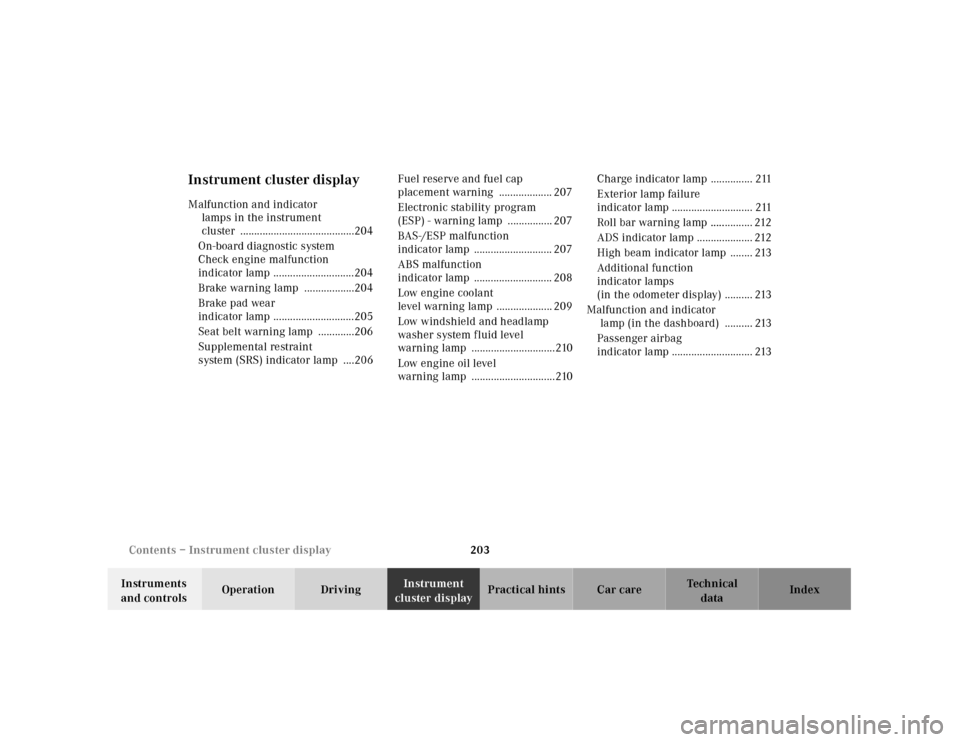
203 Contents – Instrument cluster display
Technical
data Instruments
and controlsOperation DrivingInstrument
cluster displayPractical hints Car care Index
Instrument cluster displayMalfunction and indicator
lamps in the instrument
cluster .........................................204
On-board diagnostic system
Check engine malfunction
indicator lamp .............................204
Brake warning lamp ..................204
Brake pad wear
indicator lamp .............................205
Seat belt warning lamp .............206
Supplemental restraint
system (SRS) indicator lamp ....206Fuel reserve and fuel cap
placement warning ................... 207
Electronic stability program
(ESP) - warning lamp ................ 207
BAS-/ESP malfunction
indicator lamp ............................ 207
ABS malfunction
indicator lamp ............................ 208
Low engine coolant
level warning lamp .................... 209
Low windshield and headlamp
washer system f luid leve l
warning lamp ..............................210
Low engine oil level
warning lamp ..............................210Charge indicator lamp ............... 211
Exterior lamp failure
indicator lamp ............................. 211
Roll bar warning lamp ............... 212
ADS indicator lamp .................... 212
High beam indicator lamp ........ 213
Additional function
indicator lamps
(in the odometer display) .......... 213
Malfunction and indicator
lamp (in the dashboard) .......... 213
Passenger airbag
indicator lamp ............................. 213
Page 211 of 297

207 Malfunction and indicator lamps
Technical
data Instruments
and controlsOperation DrivingInstrument
cluster displayPractical hints Car care Index Fuel reserve and fuel cap placement warning
With the key in steering lock position 2, the
fuel reserve warning lamp comes on. It
should go out immediately when the engine
is running.
If the warning lamp does not go out after starting the
engine, or if it comes on while driving, it indicates that
the fuel level is down to the reserve quantity of
approximately 2.6 gal (10 liters).
The warning lamp blinks when the fuel cap is not
closed, or a fuel system leak has been detected.
Retighten cap and see if warning lamp goes out after
restart and next OBD selfcheck.
If the warning lamp continues to blink after closing the
fuel cap correctly, have the fuel system checked at your
authorized Mercedes-Benz Center as soon as possible.
Leaving the engine running and the fuel cap open can
cause the “CHECK ENGINE” lamp to illuminate (see also
page 204).Electronic stability program (ESP) — warning lamp
The yellow ESP warning lamp in the
speedometer dial comes on with the key in
steering lock position 2. It should go out
with engine running.
See page 192 if the warning lamp lights up or flashes
when the vehicle is moving.
BAS-/ESP malfunction indicator lamp
The malfunction indicator lamp for the ESP
is combined with that of the BAS.
The yellow BAS/ESP malfunction indicator
lamp in the instrument cluster come on with the key in
steering lock position 2. They should go out with the
engine running.
If the BAS/ESP malfunction indicator lamp comes on
permanently with the engine running, see page 188
and 192.
Page 213 of 297

209 Malfunction and indicator lamps
Technical
data Instruments
and controlsOperation DrivingInstrument
cluster displayPractical hints Car care Index Low engine coolant level warning lamp
With the key in steering lock position 2, the
warning lamp comes on. It should go out
when the engine is running.
If the warning lamp does not go out after starting the
engine, or if it comes on while driving, then the coolant
level has dropped below the required level. If no leaks
are noticeable and the engine temperature does not
increase, continue to drive to the nearest service station
and have coolant added to the coolant system,
see page 224.
The low engine coolant level warning light should not be
ignored. Extended driving with the light illuminated
may cause serious engine damage not covered by the
Mercedes-Benz Limited Warranty.In cases of major or frequent minor coolant loss, have
the cooling system checked at your authorized
Mercedes-Benz Center as soon as possible.
Note:
Do not drive without coolant in the cooling system. The
engine will overheat causing major engine damage.
Monitor the coolant temperature gauge while driving.
Wa r n i n g !
Do not spill antifreeze on hot engine parts.
Antifreeze contains ethylene glycol which may
burn if it comes into contact with hot engine parts.
You can be seriously burned.
Page 214 of 297
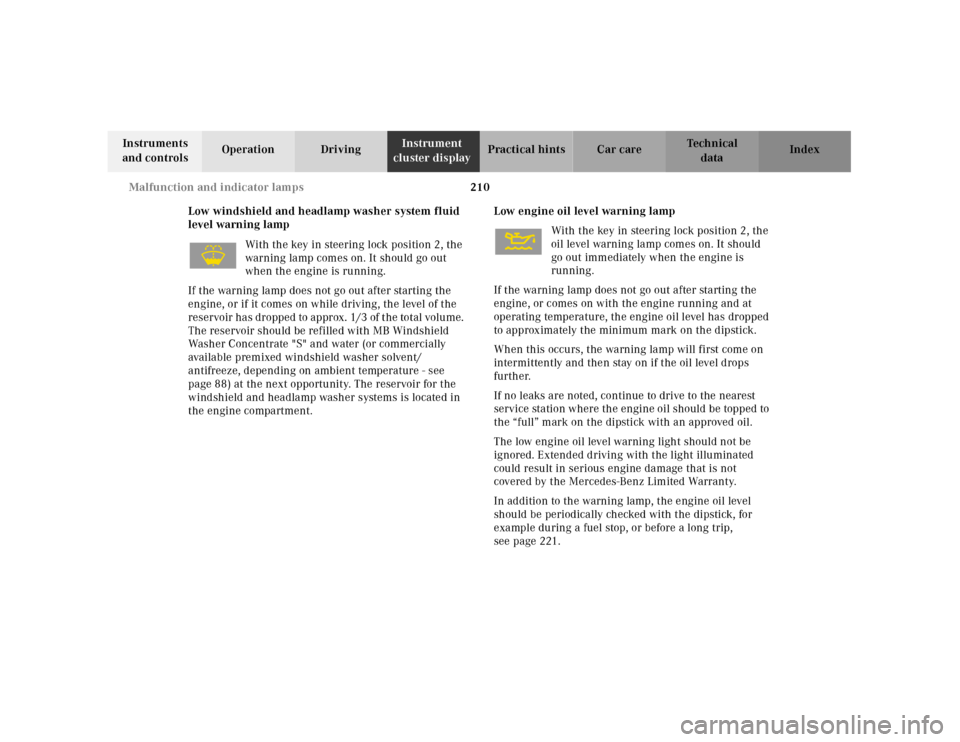
210 Malfunction and indicator lamps
Technical
data Instruments
and controlsOperation DrivingInstrument
cluster displayPractical hints Car care Index
Low windshield and headlamp washer system fluid
level warning lamp
With the key in steering lock position 2, the
warning lamp comes on. It should go out
when the engine is running.
If the warning lamp does not go out after starting the
engine, or if it comes on while driving, the level of the
reservoir has dropped to approx. 1/3 of the total volume.
The reservoir should be refilled with MB Windshield
Washer Concentrate "S" and water (or commercially
available premixed windshield washer solvent/
antifreeze, depending on ambient temperature - see
page 88) at the next opportunity. The reservoir for the
windshield and headlamp washer systems is located in
the engine compartment.Low engine oil level warning lamp
With the key in steering lock position 2, the
oil level warning lamp comes on. It should
go out immediately when the engine is
running.
If the warning lamp does not go out after starting the
engine, or comes on with the engine running and at
operating temperature, the engine oil level has dropped
to approximately the minimum mark on the dipstick.
When this occurs, the warning lamp will first come on
intermittently and then stay on if the oil level drops
further.
If no leaks are noted, continue to drive to the nearest
service station where the engine oil should be topped to
the “full” mark on the dipstick with an approved oil.
The low engine oil level warning light should not be
ignored. Extended driving with the light illuminated
could result in serious engine damage that is not
covered by the Mercedes-Benz Limited Warranty.
In addition to the warning lamp, the engine oil level
should be periodically checked with the dipstick, for
example during a fuel stop, or before a long trip,
see page 221.